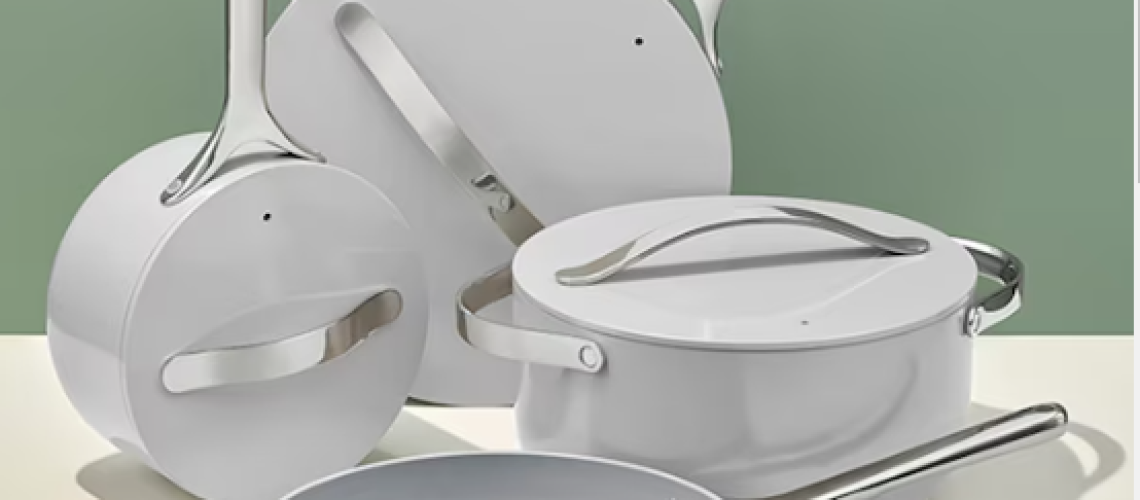When it comes to high-quality ceramic non-stick cookware, Caraway pans stand out as one of the best options available.
They’re excellent for health-conscious individuals, thanks to their non-toxic construction and exceptional non-stick properties. However, like all cookware, these pans require regular cleaning to maintain their optimal performance and aesthetics.
This article will provide a comprehensive guide on how to clean Caraway pans efficiently and effectively.
Are Caraway Pans Hard to Clean?
Not at all. In fact, one of the significant advantages of Caraway pans is their ease of cleaning. The ceramic non-stick surface allows for food to be easily wiped away, reducing the need for rigorous scrubbing that can damage the pan’s surface. However, the correct method and cleaning products will ensure the longevity of your Caraway cookware.
Can Caraway Be Washed in a Dishwasher?
While Caraway pans are technically dishwasher safe, it’s generally recommended to hand wash them. The high temperatures and harsh detergents used in dishwashers could potentially wear down the non-stick surface over time. Hand washing is gentler and will extend the life of your Caraway pans.
How Do You Get Stains Out of a Caraway Pan?
Despite the pan’s non-stick surface, you may occasionally encounter stubborn stains. These stains can be safely and effectively removed using natural cleaning agents like baking soda, which is excellent for stain removal without scratching the pan’s surface.
What You’ll Need
Before starting the cleaning process, ensure you have the following items:
- Warm water
- Mild dish detergent
- Soft sponge or scrubber
- Baking soda
- Dry towel or dishcloth
Step One: Soak the Pan
Start by filling the Caraway pan with warm water and a few drops of mild dish detergent. Let the pan soak for about 15-20 minutes. This step will help loosen any stuck-on food particles, making them easier to wipe away.
Step Two: Scrub the Pan
After soaking, drain the water and sprinkle the surface of the pan with baking soda. Using a soft sponge or gentle scrubber, scrub the pan lightly in a circular motion. Baking soda is mildly abrasive, making it effective at removing stains without scratching the ceramic surface.
Step Three: Rinse the Pan
Once you’ve thoroughly scrubbed the pan, rinse it under warm running water. Ensure that all baking soda and detergent residues are washed off, as these can affect the pan’s non-stick properties if left to dry.
Step Four: Dry the Pan
After rinsing, use a dry towel or dishcloth to wipe the pan dry thoroughly. Ensure there’s no remaining moisture, as this can cause water spots or lead to rust in the long term.
Conclusion
Caraway pans, with their high-quality non-stick ceramic surface, are a fantastic addition to any kitchen.
By following these steps, you can keep your Caraway pans looking and performing their best.
- Avoid using harsh or abrasive cleaners on your Caraway pans. Stick to mild detergents and gentle scrubbers.
- Avoid overheating your pan. Excessive heat can damage the non-stick surface.
- Always let the pan cool before washing it to prevent thermal shock, which could warp the pan.
For more information about Caraway pans and how to maintain them, visit the Caraway website or check out their comprehensive FAQ section.
There, you can find more detailed guides on cleaning and caring for your Caraway cookware and bakeware.
Happy cooking!
Frequently Asked Questions
Q: Can I use metal utensils on my Caraway pan?
A: Although Caraway pans are designed to be scratch-resistant, it’s recommended to use wooden or silicone utensils to prevent potential damage to the non-stick surface.
Q: What should I do if the non-stick surface starts to wear off?
A: Proper care and maintenance should prevent this. However, if the non-stick surface begins to degrade, it might be time to replace the pan.
Q: How often should I clean my Caraway pans?
A: Ideally, you should clean your Caraway pans after every use. This helps to maintain the non-stick surface and prevents the build-up of food residues, which can become harder to remove over time.
Q: Is it safe to use bleach or vinegar on Caraway pans?
A: It’s generally not recommended to use bleach or vinegar on Caraway pans. These substances can be too harsh and may damage the ceramic non-stick surface.
Q: Can I use steel wool or a metal scrubber to clean my Caraway pan?
A: No, using steel wool or metal scrubbers can scratch the ceramic non-stick surface. Stick to using a soft sponge or gentle scrubber to clean your Caraway pans.
Q: Is it normal for the surface of my Caraway pan to discolor over time?
A: Some slight discoloration may occur over time, particularly if you frequently use the pan at high temperatures. This is normal and should not affect the performance of the pan.
Q: I’ve burnt food onto my Caraway pan. How can I remove it?
A: If food is burnt onto your pan, fill the pan with warm water and a small amount of dish detergent. Let it soak for an hour or so, and then use a soft sponge to scrub the burnt food gently. If the food remains stuck, you can create a paste with baking soda and water, apply it to the affected area, let it sit for 15-20 minutes, then scrub gently and rinse thoroughly.
Q: Can You Use Olive Oil on Caraway Pans?
Yes, you can use olive oil on Caraway pans. However, keep in mind that oil residue can build up over time, affecting the non-stick properties. Therefore, ensure to clean the pan thoroughly after each use, especially when cooking with oil.


